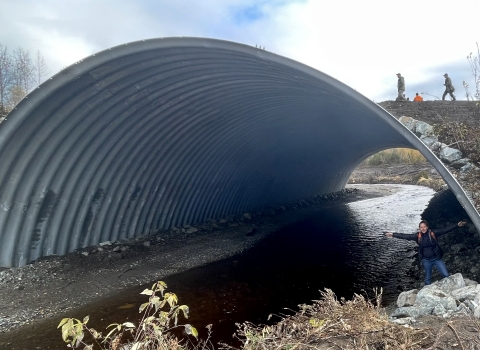“This is where the fun begins,” I thought as I got on the raft. The mission? To float down a rushing river searching for radio-tagged fish. I sat in the front with antenna in hand, the lead biologist rowing behind me and a technician snorkeling the river. While drifting downstream, I see a dark figure a few hundred feet away. Immediately I exclaim “Look, there’s a bear!” as an adult black bear crosses the river, completely ignoring our excitement. It was my first bear sighting in Washington and just another day on the Elwha River.
The Elwha River is integral to the Lower Elwha Klallam Tribe who have fished in these waters since time immemorial. Their ancestors’ canoe anchors, made of boulders and shaped by ropes and time, still rest in the riverbed. However, for nearly a century the river was transformed by two hydroelectric dams, completely blocking fish from their historical migrations. A decade ago, the Elwha River became the site of the largest dam removal project in the world, allowing for fish passage fish passage
Fish passage is the ability of fish or other aquatic species to move freely throughout their life to find food, reproduce, and complete their natural migration cycles. Millions of barriers to fish passage across the country are fragmenting habitat and leading to species declines. The U.S. Fish and Wildlife Service's National Fish Passage Program is working to reconnect watersheds to benefit both wildlife and people.
Learn more about fish passage and providing an opportunity for scientists to study the fish, wildlife, plant, and habitat response. I have had the privilege of contributing to this research, by helping to catch, radio tag, and track salmon as they return to the Elwha River to spawn. Whether it was driving, hiking, or floating down the river, every day was an adventure as we followed these fish returning home. I became familiar with certain fish based on their unique tag number frequency and followed their movements past former dam sites, each “click, click, click” from the receiver a sign of hope for future generations.
The field season transitioned to more fish hatchery evaluation work as the salmon and steelhead throughout the Olympic Peninsula returned to spawn. The Western Washington Fish and Wildlife Conservation Office supports three National Fish Hatcheries on the Olympic Peninsula. The Makah, Quilcene and Quinault National Fish Hatcheries are responsible for raising and releasing millions of salmon and steelhead to address Tribal treaty obligations and support the commercial and sport fisheries. Hatchery fish are tagged with tiny coded wire tags that reveal information including their brood year and hatchery of origin. Our job was to scan fish for tags, collect biological information from tagged fish (species, sex, and length), and retrieve their tag. Our crew of “biosamplers” ran like a well-oiled machine as we collected measurements and samples, and entered the data from thousands of fish throughout the season.
Traveling to these National Fish Hatcheries, I was able to visit different parts of Washington and have unexpected experiences along the way. From picking blackberries at Quilcene National Fish Hatchery, enjoying homemade stews at Quinault National Fish Hatchery, and visiting Neah Bay after sampling at Makah National Fish Hatchery, my experiences with the people and places encountered throughout this position were just as rewarding as the skills I gained.
While working in the field, when there was a moment to spare, I enjoyed photographing the efforts of our team. Through photography, I hope to draw more attention to the dedicated people involved in fisheries conservation. The photos below were a few of my favorites from various projects I assisted with.
At the beginning of this position, I had never worn a pair of waders and had never touched a salmon that wasn’t already filleted. In these past 8.5 months, I went from learning to walk in a river to confidently making crossings through swift water. I saw fish spawning in the rivers and hatcheries, captured and tagged juvenile and adult fish, and handled thousands of adult salmon. From the streams, rivers, lakes, and the ocean, I have become involved in the lives of these fish at every life stage, just as they have now become a part of mine.
As for my next life stage? I plan on staying in Washington State, working in fisheries conservation while deciding what grad school programs to apply for. While I am excited about fieldwork and the research side of fisheries, I am also curious about the communication of science, and how policymakers can better incorporate research and community voices into management decisions. I’ve come a long way from my childhood in the Sonoran Desert, and whatever path I choose, I am eager to apply what I’ve learned to whatever lies ahead.
Editor's Note: Eric's internship was through a partnership between the Western Washington Fish and Wildlife Conservation Office and the American Conservation Experience. American Conservation Experience is a non-profit organization dedicated to providing rewarding environmental service opportunities for young adults and emerging professionals of all backgrounds to explore and improve public lands while gaining practical professional experience.









